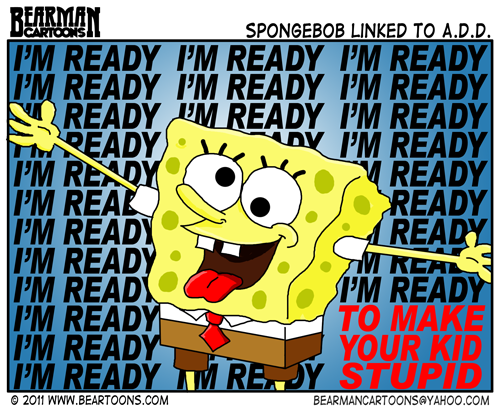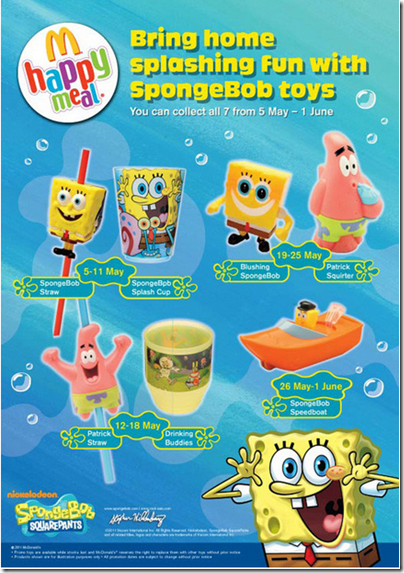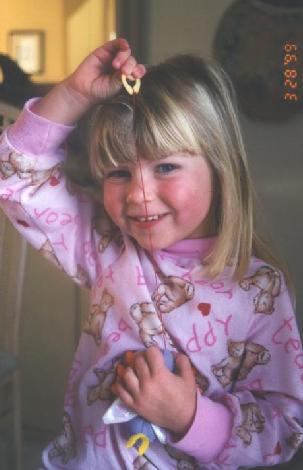 Sept. 19, 2011 “So, Amy, whose side are you on with the pundits talking and the press reporting about the new University of Virginia Spongebob research?”
Sept. 19, 2011 “So, Amy, whose side are you on with the pundits talking and the press reporting about the new University of Virginia Spongebob research?”
Whaaaa? Sides? Really? That’s cartoonish, like this editorial/visual statement at Beartoons.com at left…
Last I checked, the ability to use critical thinking skills was rarely a “one-sided” stance. I tend to take a global macro worldview with most everything, drawing from the adage “the earth is a sphere, a sphere has no sides; it’s all interconnected.”
It bemuses me that time and again this past week, many colleagues have baited me with all or nothing thinking over media mindfulness, as if supporting one stance means discounting another. Whether it’s the HASTAC initiative and announcement of Digital Lifelong Learning “badges” (see DMLBadges Twitter feed and OpenBadges.org as well as “Why badges, Why not?” and “Welcome to Badge World” two views representing opposite stances, both have strong points with which I agree) or the Spongebob/preschool harm to “executive function” from fast-pacing, these are ALL nuanced conversations that need put forth with critical reasoning not just rubberstamped in ‘yay or nay’ mode.
Think I’m using centrist ‘have it both ways’ wishy washy thinking? Hogwash.
Example: My respect for David Kleeman of American Center for Children and Media is upheld with a fistpumping “YES!” to his Spongebob media literacy education on HuffPo about how we should be researching the research rather than swallowing it whole, regardless whose it is.
Did the study find “correlation” or “causation”? What about content and context? Socio-economics? Co-viewing with parents?
He asks the right questions in a non-combative, amusing manner.
Further, he goes on to specifically write “Spongebob Squarepants and Caillou: Both of These Are NOT Like The Other” to detail the conundrum of setting up comparison contrast research between entertainment properties and educational programming…Goes to the apple/oranges issue.
Again, great stuff…must read, and we’ll get into this more in part two…
On a similar note of kudos, but a separate topic, high fives go to CCFC (Campaign for a Commercial Free Childhood.org) for their media literacy/marketing/merchandising stance, having caught Nickelodeon with their Spongebottoms down…
I agree with their assessment of how the marketing of Spongebob to preschoolers is discordant with Nickelodeon’s “expressly designed to entertain 6-to-11-year-olds,” not preschoolers statement, so yay for CCFC tossing a red flag on the play and calling a foul on Nickelodeon spinmeisters for their purposeful (PR) prose…it’s particularly relevant because of the ‘under 6’ mass merchandising brushing up against the research findings.
My Point? BOTH of these two stances (CCFC’s callout of excessive marketing/Kleeman’s deconstruction of the research) are enmeshed, interconnected, and part and parcel of what it takes to possess 21st century “critical thinking skills” universally. It’s not ‘either/or’ it is ‘and/also’ as I’ve repeated until I’m blue.
 Note to Nick though: It’s no wonder media noted the brand had to “Square Off on the Study” in defensive posture…After all, a straight up statement instead of the laughable dodge about NOT targeting (parents of) toddlers (sippy cups and 2T jammies?) would have at least saved face and parental trust a tad.
Note to Nick though: It’s no wonder media noted the brand had to “Square Off on the Study” in defensive posture…After all, a straight up statement instead of the laughable dodge about NOT targeting (parents of) toddlers (sippy cups and 2T jammies?) would have at least saved face and parental trust a tad.
By reinforcing the stereotype of industry profiteers as circling sharks that sniff out a drop of dollar “scents” that couldn’t give a flying fig about public health, cognitive research, complicity or appearances, (as long as there’s money to be made on the backs of wee ones, regardless of the ‘cost’) it frames the backdrop for a media landscape of incivility and a dustup among industry colleagues.
That single misfire succeeded in subjecting responsible media producers into ‘the usual suspects’ mode, since a public arena blame game will no doubt lump all media/marketing efforts into a generic bucket. See similar conversations about innuendo, sexualization, and other ‘research shows harm but marketers don’t care’ methodology…
 That said, with snark, send-ups and critics aplenty, there’s no shortage of those defending Spongebob’s harmlessness and dismissively hand-waving the research as well, including media Ph.D. circles like this one, The Mugging of Spongebob Squarepants from New Zealand yesterday.
That said, with snark, send-ups and critics aplenty, there’s no shortage of those defending Spongebob’s harmlessness and dismissively hand-waving the research as well, including media Ph.D. circles like this one, The Mugging of Spongebob Squarepants from New Zealand yesterday.
Author of Cartoon Monikers, Walter Brasch sums the research as:
“…Another attempt to quantify life by exorcizing a small part of life, running tests, and trying to explain human cognition and development without understanding humans.”
This is where I think we need to separate the process, the punditry, the content and the reverb.
AND…the over-arching backstory of commercialization, sales intent, and broadening of a ‘fan base’ of wee ones that could be impacted by all of the above.
This can’t be covered in a 140 character ‘tweet’ and this post alone is a 2-parter already…everyone’s getting analysis paralysis at this point…
My two cents, marketing wise, whether Nickelodeon will admit it or not, is that Spongebob product managers are undoubtedly dialing down the demographic to bring the Spongebob brand into preschool products…so to slough off the research as ‘not their audience’ is balderdash.
I happen to agree with CCFC’s fact sheet on baby/toddler marketing …this is just plain ol’ womb to tomb marketing pure and simple. Spongebob’s slowly inched towards marketing to preschoolers for eons, it just has parents and pundits sitting up and taking notice now because of the new Univ of Va research.
Why do I think CCFC is valid in calling Spongebob on their “age compression” to snag preschool eyeballs? Easy.
1.) Spongebob is an old timer, (’99 was series launch) so marketers are no doubt ramping up the next generation of productization by pulling on ‘nostalgia’ appeal to young millennial parents who may have watched the show as a teen too…This is marketing 101, folks.
2.) They’re reinforcing the ‘nag factor’ of older siblings who will “help pick out” products for junior based on THEIR OWN likes in ‘start ‘em early’ mode, but that’s empirical data based on 25 years as a creative director/new product development pro.
3.) In marketing parlance, the brand needs ‘refreshed’ with new audience/productization far beyond ‘tweens’ in order to expand market share…
To continue deconstructing…
Spongebob’s TV Twitter tale this past summer reflects just how strategic industry executives from Nickelodeon can be by building buzz and WOM/’word of mouth’ to snag attention…
Media outlets may have been befuddled and confused as to why Nickelodeon would use Twitter’s social media platform to outreach to Spongebob fans, but I sure wasn’t…
It’s pretty obvious they’re going after a slice of some of the ‘kids’ that are now ‘adults’…aka “millennials with toddlers” (under aged 32)–thus the preschool positioning.
Nickelodeon numbers show one third of adults comprise the Spongebob audience. Many of that same millennial segment now have TODDLERS. Twitter is trying to attract millennial users to sustain their platform long term for THEIR age purposes…
Add it up?
Attract AND tug at the retro heartstrings of Spongebob reveries of the millennials’ teen years, toss in a Twitter theme for hipster currency on the show to target preschoolers/parents for brand expansion (since the wee ones are too young to ‘get it’ as a show) and voila! Product line extension.
After all, it’s the adults bringing the ‘under six’ crowd to the TV set…Nickelodeon is leveraging millennial adults’ love of the show to create a new user base among toddlers. So take note CCFC, you’re spot on with the merchandising ‘connect the dots’…
This is why I’m very THANKFUL to support CCFC’s childrens’ advocacy watchdog work when they find foibles, call ‘em out, and champion change for at least the TRUTH, particularly if there’s age compression, exploitation and potential for harm in the mix…cognitive or otherwise. We should at least be informed and aware of the larger statement being made. Not alarmist or hand-wringing, just observational.
Regular readers know I often cheer for CCFC’s policies and practices, assessing each hot button from my own point of view, versus blindly supporting “any and all” in bulk.
Same with PTC/Parents’ Television Council, and other orgs like this with sharp teeth, e.g. calling out NBC as hypocrites on the airing of Playboy Club, with mixed media messaging…I strongly feel we NEED these watchdogs woofin’ whether or not we each individually embrace every campaign or not!
I’m on record with full disclosure (and a media literacy rocket flare!) that I clearly have BIAS towards organizations that put children’s health and wellness first and foremost…public health over profit. Period. Exclamation point.
 As a personal Spongebob note, even though I was keenly aware of the pilot and official series launch way back on July 17, 1999 (when my daughter, at left, was the age of the kids in the Spongebob study at the time) I would’ve never deemed it to be remotely appropriate for her developmental skill sets.
As a personal Spongebob note, even though I was keenly aware of the pilot and official series launch way back on July 17, 1999 (when my daughter, at left, was the age of the kids in the Spongebob study at the time) I would’ve never deemed it to be remotely appropriate for her developmental skill sets.
Why not?
Well, for starters, it made ME nuts with the frenetic attention span style high stim noise and bright colorful flash-n-crash pacing much less her already-gonzo-active-rarely sleepy temperament, so to me the whole ‘watch or not’ would’ve been a non-issue.
Still, I DO recall the media cultural tic of adult humor and traction that Spongebob received right away…I’d hear clerks at stores, parents, friends, ‘park talk’ (akin to watercooler chatter) speak as if I knew all about this critter living in a pineapple under the sea.
They’d toss out “Squidward, Sandy Cheeks, and Mr. Krabs” lexicon faster than you can say “Bikini Bottom” as if it were daily headline news. Clearly I was absent from the pop culture zeitgeist at the time.
Aware…but absent.
When I finally DID watch, it was easy to see how it could sustain a tween and older audience, as it’s more of an ‘adult swim’ at Bikini Bottom with sophisticated humor, wordplay, even innuendo and subtext—far more nuanced than a basic cartoon with elementary appeal…
It’s VERY obviously not ‘toddler’ content, for reasons far beyond the pacing and fast-frame developmental context.
From a ‘what to view’ media question for the pre-K set, Sesame Street and PBS Kids’ Between the Lions were pretty much the joy juice of that era for us, with what little we saw.
It’s important to note that Spongebob had adults and older siblings yakking about the show almost incessantly. And even though I found the character’s voices and snark to be shrill and annoying, I loved the marine bio theme as a water rat and the humor was more for ‘me than her.’
It’s no wonder many teens, millennials and adults can STILL be found sprawled in veg-out mode enjoying the characters even though they’ve ‘aged up’ but not ‘out’ of the Spongebob sea…
Spongebob is Nickelodeon’s tsunami of a success, written to sweep up multiple generations in its current.
So this is my prelude to part two of this post, as we segue to a full tilt effort to “deconstruct the Spongebob research” from a preschool parent lens using critical thinking skills to finesse and address each of the bugaboos of both the study and the industry practices.
We always try to go right to ‘the trenches’ to hear directly from those being MOST impacted by media and marketing’s influence on kids, so Karen Dahl our guest author in part two, is a parent of not one, but TWO preschool children, exemplifying the age group smack dab in the crosshairs of this Spongebob research study.
Karen began unveiling her own media literacy and research acumen for Shaping Youth in this piece: Grab-n-Go Squeezable Pouch Foods: Ease or Eww? before tackling Spongebob. I’m working on bringing Karen aboard to help with the preschool ‘beat’ in citizen journalism mode for a monthly or quarterly column…so please warmly welcome, Karen Dahl, with part two of Shaping Youth’s deconstruction.
p.s. Meanwhile, just for giggles, (PLEASE IGNORE THE MISLEADING HEADLINE and fasten media literacy hats…)
Here’s a family of indie, goofy, fun filmmakers, the Schweitzers out of Canada who turn their satirical slant on the research, using their young spokeschild to rattle off words in mock indignation…
I started surfing their other YouTube videos at AngrySlop Productions and it’s obvious this family is quite the scriptwriting ‘UGC’ (user generated content) crowd cranking out media mixes with different age groups and acumens to help each other not just critique but PRODUCE shows about media matters.
Yes, it’s sheer entertainment with scripts, demos, and Fx for family media literacy fun, but wow. I wish I had INTERNS like this! Rock on!
Visual Credit: Spongebob Terminator–Flickr









This whole controversy brought up two anecdotes, both true…
When my schizophrenic sister visited, she spent 6 days on the couch, eating junk food and watching SpongeBob, it was oddly comforting to see her so contained…
At a local grocery store the checkout clerk was on a ranting rampaging mission to tell everyone about “CatDog’ a cartoon she saw on television. In a moment of insight, I lied and said I never saw or heard of it. She went on to say her minister was seeking support to get it off the air, since, “We all know there aint but one way to get a cat dog and it goes aginst (sic) the Bible.. it’s beastility (sic) in the flesh!’ Whereas my initial response was more in line with my niece’s ‘how do they poo?’
I wanna leave cartoons alone but then I am reminded that the above mentioned sister tried to stab littlest sister in head with scissors after seeing Moe do it on the 3 Stooges…
It’s a strange world and at 55, I see it getting stranger. Glad there are Mom’s like you pouring a little common sense on the fire.
Can’t thank you enough for taking time to leave a comment…like tumbleweeds out here in ‘long form blogging’ when people are tweeting and status lining convos in snackerels and tidbits. heh. 😉 Your comment about extremes w/the checkout clerk on a mission left me laughing at your retort…as I always try to stay in ‘centrist zone’ to deconstruct the ages/stages for cultural context in terms of how the media is landing.
Which reminds me…I just tweeted out that Fox is heavily marketing Sunday nights as “animation domination” but they’re NOT cartoons for kids…they’re all adult swims/innuendo/content for “big kids” so this is another example of ‘connecting the dots’ with critical thinking skills instead of turning a blind eye.
Sure, I’d like to think people do a double take to know just because it says ‘family’ in the title doesn’t mean ‘Family Guy’ is apropos…but anecdotal research keeps popping up to the contrary, making long form deconstruction and ‘media lit’ training a ‘must.’ 😉
Thanks again for taking the time to lob a note my way…keeps me goin!